Satellite-Based Innovative Agroclimatic Classification Under Reduced Water Availability: Identification of Optimal Productivity Zones
Abstract
1. Introduction
2. Agroclimatic Zoning Methodology
2.1. Hydroclimatic Zoning
2.1.1. Vegetation Health Index (VHI)
2.1.2. Aridity Index (AI)
2.1.3. Hydroclimatic WLGE Zones
2.2. Non-Crop-Specific Agroclimatic Zoning
2.2.1. Multi-Criteria Decision-Making (MCDM) Approach
- -
- Step 1: selecting suitable criteria;
- -
- Step 2: conducting pairwise comparison of criteria;
- -
- Step 3: validating the results.
2.2.2. Non-Crop-Specific Model
2.3. Crop-Specific Agroclimatic Zoning
2.3.1. Growing Degree Days
2.3.2. Net Radiation (Rn)
2.3.3. Spring Precipitation
2.3.4. Crop-Specific Agroclimatic Map
3. Study Areas and Databases
3.1. Description of Study Areas
3.1.1. Greek Study Area
3.1.2. Portuguese Study Area
3.1.3. French Study Area
3.2. Dataset and Preprocessing
3.2.1. Hydroclimatic Zoning Database
- -
- The median rainfall is derived by pentad CHIRPS (Climate Hazards Group InfraRed Precipitation with Station) data for the period 2001–2022. CHIRPS integrates satellite and in situ precipitation data, with a spatial resolution about 5 Km [68]. Although this rainfall product provides data from 1981 to present, the previous specific period is employed to achieve temporal compatibility with precipitation MODIS data. Then, 1584 CHIRPS pentad data points were processed for each study area (4752 images in total, for the period under consideration). There is consistency between the CHIRPS data and ground precipitation data based on a comparison between Larissa (Greece) station precipitation data and the corresponding CHIRPS pixel values.
- -
- The median potential evapotranspiration (PET) is derived from MODIS data (MOD16A2) for a time range of 2001 to 2022. The MOD16A2 product provides 8-day composite dataset PET layer at a 500 m spatial resolution (https://doi.org/10.5067/MODIS/MOD16A2.006). In each study area, in Greece, France, Portugal, 1010 data points were processed (3030 images in total).
3.2.2. Non-Crop-Specific Agroclimatic Zoning Database
- -
- The topographic surface. The digital elevation model (DEM) is available globally, at 30 m spatial resolution by the U.S. Geological Survey [69].
- -
- Soil dataset. For the Greek study area, the soil types are derived from the International Soil Reference and Information Centre (ISRIC) at a spatial resolution of 250 m [70]. For the other two study areas, the soil maps are provided by the national databases.
- -
- Land use/land cover (LU/LC). For the Greek study areas, the Corine Land Cover product (2018) was applied. It can be downloaded for free from the Copernicus Land Monitoring Service [71]. For the Portugal study area, LU/LC maps are provided by local institutions. For the France study area, the agricultural land use is provided by the EU land parcel identification system, completed with the land use provided by the THEIA program.
3.2.3. Crop-Specific Agroclimatic Zoning Database
- -
- The median GDD over 22 years is calculated based on the MODIS product. Specifically, the average 8-day land surface temperature dataset at a 1 Km spatial resolution (MOD11A2 V6) is processed for the period 2001–2022. For the three study areas, the median GDD for each crop and growing period are considered. For instance, for the winter crop, wheat, 462 8-day MOD11A2 data points are considered for each one of the three study areas, for the period January to 15 June (1386 images in total). Likewise, for the irrigated crop maize, 505 8-day MOD11A2 data points for Thessaly and Évora-Portalegre regions are analyzed (1010 in total) during the growing period from April to September. For the hay crop in Crau area, the GDD product is derived from 242 8-day MOD11A2 data points for the period March to May.
- -
- For each crop growing season, the median net radiation is calculated by processing 10 years of Landsat-8 satellite data (2013–2022). Regarding the non-irrigated annual crops (wheat), the net radiation calculations are performed in the three study areas of Thessaly, Évora-Portalegre, and Crau, using Landsat data with 505, 469, and 232 images, respectively. Furthermore, for the maize irrigated crops in Thessaly and Évora-Portalegre regions, 648 and 571 Landsat images are considered respectively. Finally, for the hay crop, the net radiation is derived from 120 Landsat data points.
- -
- The 41-year CHIRPS pentad precipitation data (period 1981–2022) is employed to calculate the median 20-day spring cumulative precipitation. For each one of the three study areas, 176 datasets, through the GEE platform, are processed.
3.2.4. Coordinate Systems
3.2.5. Downscaling Data
- -
- Load and preprocess data. Import the GDD image collection alongside high-resolution elevation data (ALOS DSM: Global 30 m v4.1, approximately 30 m horizontal resolution).
- -
- Generate training dataset. Extract paired pixel values from GDD and ALOS DSM datasets. In total, 1000 pixels are sampled.
- -
- Create a chart regression to assess the correlation between the two variables. This approach is effective, as it visually demonstrates the strength and nature of the relationship between the elevation and GDD (Figure 6), where the Pearson correlation value between GDD and Elevation is −0.89, which indicates a very strong negative linear relationship.
- -
- Train the model. Utilize the extracted samples to train the CART regression model predicting the GDD from elevation.
- -
- Apply model for downscaling. Employ the trained model across the 30 m elevation data to generate a GDD dataset at 30 m resolution.
- -
- Validate results. The evaluation of the final downscaled product is performed using LST data obtained from local meteorological stations.
4. Implementation of the Agroclimatic Zoning Methodology
4.1. Implementation of Hydroclimatic Classification
- I.
- Vegetation Health Index (VHI)
- II.
- Aridity Index (AI)
- III.
- Water-Limited Growth Environment (WLGE) Zones
4.2. Non-Crop-Specific Agroclimatic Zoning
4.3. Crop-Specific Agroclimatic Zoning
- I.
- Growing Degree Days (GDD)
- II.
- Net Radiation
- III.
- Amount of Spring Precipitation
5. Results
5.1. Implementation of Non-Crop-Specific Agroclimatic Zoning
5.2. Implementation of Crop-Specific Agroclimatic Zoning
5.2.1. Wheat Agroclimatic Zoning
5.2.2. Maize—Hay Agroclimatic Zoning
5.2.3. Productivity Agroclimatic Zoning
6. Discussion
7. Summary and Conclusions
Author Contributions
Funding
Data Availability Statement
Acknowledgments
Conflicts of Interest
Abbreviations
| AEZ | Agroecological Zoning |
| AI | Aridity Index |
| EO | Earth Observation |
| FAO | Food and Agriculture Organization |
| GDD | Growing Degree Days |
| GEE | Google Earth Engine |
| GIS | Geographic Information System |
| LST | Land Surface Temperature |
| NDVI | Normalized Difference Vegetation Index |
| Rn | Net Radiation |
| VCI | Vegetation Condition Index |
| VHI | Vegetation Health Index |
| WLGE | Water-Limited Growth Environment |
References
- Pereira, L.S. Water, agriculture, and food: Challenges and issues. Water Resour. Manag. 2017, 31, 2985–2999. [Google Scholar] [CrossRef]
- IPCC. Managing the Risks of Extreme Events and Disasters to Advance Climate Change Adaptation. A Special Report of Working Groups I and II of the Intergovernmental Panel on Climate Change; Field, C.B., Barros, V., Stocker, T.F., Qin, D., Dokken, D.J., Ebi, K.L., Mastrandrea, M.D., Mach, K.J., Plattner, G.-K., Allen, S.K., et al., Eds.; Cambridge University Press: Cambridge, UK; New York, NY, USA, 2012. [Google Scholar]
- Flato, G.; Marotzke, J.; Abiodun, B.; Braconnot, P.; Chou, S.C.; Collins, W.; Cox, P.; Driouech, F.; Emori, S.; Eyring, V.; et al. Evaluation of Climate Models. In Climate Change 2013: The Physical Science Basis. Contribution of Working Group I to the Fifth Assessment Report of the Intergovernmental Panel on Climate Change; Stocker, T.F., Qin, D., Plattner, G.-K., Tignor, M., Allen, S.K., Boschung, J., Nauels, A., Xia, Y., Bex, V., Midgley, P.M., Eds.; Cambridge University Press: Cambridge, UK; New York, NY, USA, 2013; Available online: https://elib.dlr.de/95697/ (accessed on 20 July 2024).
- Senapati, N.; Stratonovitch, P.; Paul, M.J.; Semenov, M.A. Drought tolerance during reproductive development is important for increasing wheat yield potential under climate change in Europe. J. Exp. Bot. 2018, 70, 2549–2560. [Google Scholar] [CrossRef]
- Cammarano, D.; Ceccarelli, S.; Grando, S.; Romagosa, I.; Benbelkacem, A.; Akar, T.; AlYassin, A.; Pecchioni, N.; Francia, E.; Ronga, D. The impact of climate change on barley yield in the Mediterranean basin. Eur. J. Agron. 2019, 106, 1–11. [Google Scholar] [CrossRef]
- Van Leeuwen, C.; Friant, P.; Choné, X.; Tregoat, O.; Koundouras, S.; Dubourdieu, D. Influence of climate, soil, and cultivar on terroir. Am. J. Enol. Vitic. 2004, 55, 207–217. [Google Scholar] [CrossRef]
- Santos, J.A.; Malheiro, A.C.; Karremann, M.K.; Pinto, J.G. Statistical modelling of grapevine yield in the Port Wine region under present and future climate conditions. Int. J. Biometeorol. 2011, 55, 119–131. [Google Scholar] [CrossRef]
- Soares, D.; Paredes, P.; Paço, T.A.; Rolim, J. Projected Bioclimatic Changes in Portugal: Assessing Maize Future Suitability. Agronomy 2025, 15, 592. [Google Scholar] [CrossRef]
- Vicente-Serrano, S.M.; Peña-Angulo, D.; Beguería, S.; Domínguez-Castro, F.; Tomás-Burguera, M.; Noguera, I.; Gimeno-Sotelo, L.; El Kenawy, A. Global drought trends and future projections. Philos. Trans. R. Soc. A 2022, 380, 20210285. [Google Scholar] [CrossRef]
- Mavi, H.S.; Tupper, G.J. Agrometeorology: Principles and Applications of Climate Studies in Agriculture, 1st ed.; Food Products Press: New York, NY, USA, 2004; p. 381. Available online: https://yangiasr.uz/files/books/2025-05-16-11-10-51_9b75ae2215390fc9970073e3d27b38ba.pdf (accessed on 1 August 2024).
- Wall, E.; Barry, S. Climate Change Adaptation in Light of Sustainable Agriculture. J. Sustain. Agric. 2005, 27, 113–123. [Google Scholar] [CrossRef]
- Fletcher, J.A.; Hurlbert, M.; Hage, S.; Sauchyn, D. Agricultural Producers’ Views of Climate Change in the Canadian Prairies: Implications for Adaptation and Environmental Practices. Soc. Nat. Resour. 2021, 34, 331–351. [Google Scholar] [CrossRef]
- Tow, P.G. Factors in the development and classification of dryland farming systems. In Dryland Farming: A Systems Approach: An Analysis of Dryland Agriculture in Australia; Squire, V., Tow, P., Eds.; Publisher University Press: Sydney, Australia, 1991; pp. 12–17. [Google Scholar]
- FAO. Agro Ecological Zoning: Guidelines; Soils Bulletin No. 73; Food and Agriculture Organization of the United Nations: Rome, Italy, 1996; Available online: https://wgbis.ces.iisc.ac.in/energy/HC270799/LM/SUSLUP/FAO/SB73AEZ.PDF (accessed on 5 August 2024).
- Fischer, G.; Nachtergaele, F.; Prieler, S.; Teixeira, E.; Toth, G.; Velthuizen, H.; Verelst, L.; Wiberg, D. Global Agro-Ecological Zones (GAEZ v3.0)—Model Documentation; Food and Agriculture Organization of the United Nations: Rome, Italy, 2012; Available online: https://www.gaez.iiasa.ac.at/docs/GAEZ_Model_Documentation.pdf (accessed on 10 August 2024).
- Fischer, G.; Nachtergaele, F.O.; Van Velthuizen, H.T.; Chiozza, F.; Franceschini, G.; Henry, M.; Muchoney, D.; Tramberend, S. Global Agro-Ecological Zones v4—Model Documentation; Food and Agriculture Organization of the United Nations: Rome, Italy, 2021; Available online: https://openknowledge.fao.org/items/039f7ec9-98af-49e1-8d24-850122c69bef (accessed on 10 August 2024).
- Malheiro, A.; Santos, J.; Fraga, H.; Pinto, J. Climate change scenarios applied to viticultural zoning in Europe. Clim. Res. 2010, 43, 163–177. [Google Scholar] [CrossRef]
- Tsiros, E.; Domenikiotis, C.; Dalezios, R.N. Sustainable production zoning for agroclimatic classification using GIS and remote sensing. Időjárás 2009, 113, 55–68. [Google Scholar]
- Adnan, S.; Ullah, K.; Gao, S.; Khosa, A.H.; Wang, Z. Shifting of agro-climatic zones, their drought vulnerability, and precipitation and temperature trends in Pakistan. Int. J. Climatol. 2017, 37, 529–543. [Google Scholar] [CrossRef]
- Falasca, S.L.; Fresno, M.D.; Waldman, C. Developing an agro-climatic zoning model to determine potential growing areas for Camelina sativa in Argentina. QScience Connect 2014, 2014, 1–11. [Google Scholar] [CrossRef]
- Moeletsi, E.M.; Walker, S. A simple agroclimatic index to delineate suitable growing areas for rainfed maize production in the Free State Province of South Africa. Agric. For. Meteorol. 2012, 162–163, 63–70. [Google Scholar] [CrossRef]
- Araya, A.; Keesstra, S.D.; Stroosnijder, L.A. New agro-climatic classification for crop suitability zoning in northern semi-arid Ethiopia. Agric. For. Meteorol. 2010, 150, 1057–1064. [Google Scholar] [CrossRef]
- Dalezios, N.; Dercas, R.N.; Blanta, A.; Faraslis, I. Remote Sensing in Water Balance Modelling for Evapotranspiration at a Rural Watershed in Central Greece. Int. J. Sustain. Agric. Manag. Inform. 2019, 4, 306–337. [Google Scholar] [CrossRef]
- Reddy, S.I. Agroclimatic classification of the semi-arid topics. I. A method for the computation classification variables. Agr. Meteorol. 1983, 30, 185–200. [Google Scholar] [CrossRef]
- Badini, O.; Stocle, C.O.; Franz, E.H. Application of crop simulation modeling and GIS to agroclimatic assessment in Burkina. Faso. Agric. Ecosyst. Environ. 1997, 64, 233–244. [Google Scholar] [CrossRef]
- Kogan, F.N. Operational space technology for global vegetation assessment. Bull. Am. Meteorol. Soc. 2001, 82, 1949–1964. [Google Scholar] [CrossRef]
- Thenkabail, P.S.; Gamage, M.S.D.N.; Smakhtin, V.U. The Use of Remote Sensing Data for Drought Assessment and Monitoring in Southwest Asia, Research Report No. 85; International Water Management Institute: Colombo, Sri Lanka, 2004; pp. 1–34. Available online: https://www.unisdr.org/files/1871_VL102138.pdf (accessed on 5 September 2024).
- Dalezios, R.N. Remote Sensing Applications in Environmental and Earth System Science; Taylor & Francis, CRC Group: Boca Raton, FL, USA, 2021; p. 388. ISBN 978-1-138-05456-1. [Google Scholar] [CrossRef]
- Dayal, D.; Pandey, A.; Gupta, K.P.; Himanshu, L.S. Multi-criteria evaluation of satellite-based precipitation estimates over agro-climatic zones of India. Atmos. Res. 2023, 292, 106879. [Google Scholar] [CrossRef]
- Niemeyer, S. New drought indices. In Drought Management: Scientific and Technological Innovations; Options Méditerranéennes: Série A. Séminaires Méditerranéens, n. 80; López-Francos, A., Ed.; CIHEAM: Zaragoza, Spain, 2008; pp. 267–274. Available online: http://om.ciheam.org/om/pdf/a80/00800451.pdf (accessed on 15 September 2024).
- Gorelick, N.; Hancher, M.; Dixon, M.; Ilyushchenko, S.; Thau, D.; Moore, R. Google Earth Engine: Planetary-scale geospatial analysis for everyone. Remote Sens. Environ. 2017, 202, 18–27. [Google Scholar] [CrossRef]
- Faraslis, I.; Dalezios, N.R.; Alpanakis, N.; Tziatzios, G.A.; Spiliotopoulos, M.; Sakellariou, S.; Sidiropoulos, P.; Dercas, N.; Domínguez, A.; Martínez-López, J.A.; et al. Remotely Sensed Agroclimatic Classification and Zoning in Water-Limited Mediterranean Areas towards Sustainable Agriculture. Remote Sens. 2023, 15, 5720. [Google Scholar] [CrossRef]
- Patel, Ν.R.; Umesh, K.M.; Pande, L.M. Agro-ecological Zoning System-A Remote Sensing and GIS Perspective. J. Agrometeorol. 2000, 2, 1–13. [Google Scholar] [CrossRef]
- Kogan, F.N. World droughts in the new millennium from AVHRR-based vegetation health indices. Eos Trans. Am. Geophys. Union. 2002, 83, 557–563. [Google Scholar] [CrossRef]
- Masitoh, F.; Rusydi, N.A. Vegetation Health Index (VHI) analysis during drought season in Brantas Watershed. IOP Conf. Ser. Earth Environ. Sci. 2019, 389, 012033. [Google Scholar] [CrossRef]
- Brown, T. Design Thinking. Harv. Bus. Rev. 2008, 86, 84–92. [Google Scholar]
- McVicar, T.R.; Jupp, D.L.B. The current and potential operational uses of remote sensing to aid decisions on drought exceptional circumstances in Australia. A review. Agric. Syst. 1998, 57, 399–468. [Google Scholar] [CrossRef]
- European Space Agency (ESA). 2024. Available online: https://www.esa.int/ (accessed on 26 July 2024).
- Ke, Y.; Im, J.; Park, S.; Gong, H. Downscaling of MODIS One Kilometer Evapotranspiration Using Landsat-8 Data and Machine Learning Approaches. Remote Sens. 2016, 8, 215. [Google Scholar] [CrossRef]
- Elnashar, A.; Zeng, H.; Wu, B.; Zhang, N.; Tian, F.; Zhang, M.; Zhu, W.; Yan, N.; Chen, Z.; Sun, Z.; et al. Downscaling TRMM Monthly Precipitation Using Google Earth Engine and Google Cloud Computing. Remote Sens. 2020, 12, 3860. [Google Scholar] [CrossRef]
- Karbalaye Ghorbanpour, A.; Hessels, T.; Moghim, S.; Afshar, A. Comparison and assessment of spatial downscaling methods for enhancing the accuracy of satellite-based precipitation over Lake Urmia Basin. J. Hydrol. 2021, 596, 126055. [Google Scholar] [CrossRef]
- Zuhro, A.; Tambunan, M.; Marko, K. Application of vegetation health index (VHI) to identify distribution of agricultural drought in Indramayu Regency, West Java Province. IOP Conf. Ser. Earth Environ. Sci. 2020, 500, 012047. [Google Scholar] [CrossRef]
- Zeng, J.; Zhang, R.; Qu, Y.; Bento, A.V.; Zhou, T.; Lin, Y.; Wu, X.; Qi, J.; Shui, W.; Wang, Q. Improving the drought monitoring capability of VHI at the global scale via ensemble indices for various vegetation types from 2001 to 2018. Weather Clim. Extrem. 2022, 35, 100412. [Google Scholar] [CrossRef]
- Kogan, F.N. Remote sensing of weather impacts on vegetation in non-homogeneous areas. Int. J. Remote Sens. 1990, 11, 1405–1419. [Google Scholar] [CrossRef]
- Bento, V.A.; Trigo, I.F.; Gouveia, C.M.; DaCamara, C.C. Contribution of Land Surface Temperature (TCI) to Vegetation Health Index: A Comparative Study Using Clear Sky and All-Weather Climate Data Records. Remote Sens. 2018, 10, 1324. [Google Scholar] [CrossRef]
- Middleton, N.; Thomas, D. World Atlas of Desertification; Arnold: London, UK; New York, NY, USA; Sydney, Australia; Auckland, New Zealand, 1997; p. 182. Available online: https://wedocs.unep.org/handle/20.500.11822/30300 (accessed on 1 August 2024)ISBN 0340691662.
- Kimura, R.; Moriyama, M. Recent Trends of Annual Aridity Indices and Classification of Arid Regions with Satellite-Based Aridity Indices. Remote Sens. Earth Syst. Sci. 2019, 2, 88–95. [Google Scholar] [CrossRef]
- FAO. Forest Resources Assessment 1990. Tropical Countries, Forestry Paper 112; Food and Agriculture Organization of the United Nations (FAO): Rome, Italy, 1993; Available online: https://www.fao.org/4/t0830e/t0830e00.htm (accessed on 10 August 2024).
- Ashaolu, E.D.; Iroye, K.A. Rainfall and potential evapotranspiration patterns and their effects on climatic water balance in the Western Lithoral Hydrological Zone of Nigeria. Ruhuna J. Sci. 2018, 9, 92–116. [Google Scholar] [CrossRef]
- FAO. Guidelines: Land Evaluation for Irrigated Agriculture—FAO Soils Bulletin 55; Food and Agriculture Organization of the United Nations (FAO): Rome, Italy, 1985; Available online: https://www.fao.org/4/x5648e/x5648e00.htm#Contents (accessed on 1 March 2024).
- Saaty, T.L. A scaling method for priorities in hierarchical structure. J. Math. Psychol. 1977, 15, 234–281. [Google Scholar] [CrossRef]
- McMaster, S.; Wilhelm, G. Growing degree-days: One equation, two interpretations. Agric. For. Meteorol. 1997, 87, 291–300. [Google Scholar] [CrossRef]
- Kustas, W.P.; Daughtry, C.S.T. Estimation of the soil heat flux/net radiation ratio from multispectral data. Agric. For. Meteorol. 1990, 49, 205–223. [Google Scholar] [CrossRef]
- Sadeghi, M.; Ebtehaj, A.; Guala, M.; Wang, J. Physical connection of sensible and ground heat flux. J. Hydrol. 2021, 602, 126687. [Google Scholar] [CrossRef]
- Tasumi, M.; Allen, R.G.; Trezza, R. At-surface reflectance and albedo from satellite for operational calculation of land surface energy balance. J. Hydrol. Eng. 2008, 13, 51–63. [Google Scholar] [CrossRef]
- Bastiaanssen, W.G.M.; Menenti, M.; Feddes, R.A.; Holtslag, A.A.M. A remote sensing surface energy balance algorithm for land (SEBAL): 1. Formulation. J. Hydrol. 1998, 212–213, 198–212. [Google Scholar] [CrossRef]
- Allen, R.G.; Tasumi, M.; Trezza, R. Satellite-based energy balance for mapping evapotranspiration with internalized calibration (METRIC)-Model. J. Irrig. Drain. Eng. 2017, 133, 380–394. [Google Scholar] [CrossRef]
- Dalezios, N.R.; Stamatopoulou, I. The Significance of Meteorological Indices in the Phenology of Maize in Central Greece. In Proceedings of the International Symposium on Applied Agrometeorology-Agroclimatology, Volos, Greece, 24–26 April 1996; Dalezios, N.R., Tzortzios, S., Eds.; University of Thessaly: Volos, Greece, 1996; pp. 411–417. [Google Scholar]
- Bampzelis, D.; Domenikiotis, C.; Dalezios, N.R. Phenological and Agrometeorological Indices Related to Wheat Production in Central Greece. In Proceedings of the International Conference on Information Systems in Sustainable Agriculture, Agroenvironment and Food Technology, Volos, Greece, 20–23 September 2006; Dalezios, N.R., Tzortzios, G., Eds.; HAICTA and EC: Volos, Greece, 2006; pp. 795–802. [Google Scholar]
- Mylopoulos, N.; Kolokytha, E.; Loukas, A.; Mylopoulos, Y. Agricultural and water resources development in Thessaly, Greece in the framework of new European Union policies. Int. J. River Basin Manag. 2009, 7, 73–89. [Google Scholar] [CrossRef]
- Beck., H.E.; Zimmermann., N.E.; McVicar., T.; Vergopolan., N.; Berg., A.; Wood., E.F. Present and future Köppen-Geiger climate classification maps at 1-km resolution. Sci. Data 2018, 5, 180214. [Google Scholar] [CrossRef]
- IPMA. Climate Normals—1981–2010. 2024. Available online: https://www.ipma.pt/pt/oclima/normais.clima/1981-2010/#562 (accessed on 5 July 2024).
- WRB; Food and Agriculture Organization of the United Nations, International Union of Soil Sciences. World Reference Base for Soil Resources 2014. International Soil Classification System for Naming Soils and Creating Legends for Soil Maps-Update 2015; World Soil Resources Reports No. 106; Food and Agriculture Organization: Rome, Italy, 2015; Available online: https://openknowledge.fao.org/server/api/core/bitstreams/bcdecec7-f45f-4dc5-beb1-97022d29fab4/content (accessed on 5 November 2024).
- Instituto Nacional de Estatística (INE). Database. Lisboa, Portugal: Instituto Nacional de Estatística. 2024. Available online: https://www.ine.pt/ (accessed on 5 July 2024).
- Instituto Nacional de Estatística (INE). Recenseamento Agrícola 2019, Plataforma de Divulgação Resultados Finais; Instituto Nacional de Estatística: Lisboa, Portugal, 2024; Available online: https://www.ine.pt/scripts/db_ra_2019.html (accessed on 10 July 2024).
- INRAE. Base de Données Géographique des Sols de France à 1/1 000 000. 2018. Available online: https://entrepot.recherche.data.gouv.fr/dataset.xhtml?persistentId=doi:10.15454/BPN57S (accessed on 5 November 2024).
- Marson, P.; Corre, L.; Soubeyroux, J.M.; Sauquet, E.; Robin, Y.; Vrac, M.; Dubois, C. Explore2–Rapport de Synthèse sur les Projections Climatiques Régionalisées. Technical Report, Meteo France, INRAE, Institut Pierre-Simon Laplace. 2024. Available online: https://hal.inrae.fr/hal-04443633v1 (accessed on 1 November 2024).
- Funk, C.; Peterson, P.; Landsfeld, M.; Pedreros, D.; Verdin, J.; Shukla, S.; Husak, G.; Rowland, J.; Harrison, L.; Hoell, A.; et al. The climate hazards infrared precipitation with stations—A new environmental record for monitoring extremes. Sci. Data 2015, 2, 150066. [Google Scholar] [CrossRef]
- U.S. Geological Survey. Shuttle Radar Topography Mission (SRTM). 2024. Available online: https://earthexplorer.usgs.gov/ (accessed on 10 June 2024).
- Batjes, N.H. ISRIC-WISE Harmonized Global Soil Profile Dataset (Ver. 3.1). Report2008/02, ISRIC—World Soil Information, Wageningen (with Dataset). 2008. Available online: https://www.researchgate.net/publication/37790384_ISRIC-WISE_Harmonized_Global_Soil_Profile_Dataset_Ver_31 (accessed on 5 July 2024).
- Copernicus Land Monitoring Service. CORINE Land Cover 2018. European Environment Agency (EEA). 2018. Available online: https://land.copernicus.eu/pan-european/corine-land-cover/clc2018 (accessed on 15 July 2024).
- Matzarakis, A.; Dafinka, I.; Balafoutis, C.; Makrogiannis, T. Climatology of growing degree days in Greece. Clim. Res. 2007, 34, 233–240. [Google Scholar] [CrossRef]
- FAO. Annexes, AquaCrop Version 7.1. Reference Manual; Food and Agriculture Organization of the United Nations: Rome, Italy, 2023; Available online: https://openknowledge.fao.org/server/api/core/bitstreams/1479f444-c112-4faa-b3dc-bc73b0637332/content (accessed on 5 August 2024).
- Gihan, M.; Trolard, F.; Bourrié, G.; Gillon, M.; Tronc, D.; Charron, F.A. Long-Term Data Sequence (1960–2013) to Analyse the Sustainability of Hay Quality in Irrigated Permanent Grasslands Under Climate Change. Am. J. Agric. For. 2016, 4, 140–151. [Google Scholar] [CrossRef]
- Breazeale, D.; Kettle, R.; Munk, G. Using Growing Degree Days for Alfalfa Production. Fact Sheet 99-71. University of Nevada, Cooperative Extension. Available online: https://www.haytalk.com/attachments/uofn-growth-degree-days-pdf.31362/ (accessed on 1 July 2024).
- Merot, A.; Bergez, J.E.; Wallach, D.; Duru, M. Adaptation of a functional model of grassland to simulate the behaviour of irrigated grasslands under a Mediterranean climate: The Crau case. Eur. J. Agron. 2008, 29, 163–174. [Google Scholar] [CrossRef]
- Ingrao, C.; Strippoli, R.; Lagioia, G.; Huisingh, D. Water scarcity in agriculture: An overview of causes, impacts and approaches for reducing the risks. Heliyon 2023, 9, e18507. [Google Scholar] [CrossRef]
- Bandyopadhyay, S.; Jaiswal, R.K.; Hegde, V.S.; Jayaraman, V. Assessment of land suitability potentials for agriculture using a remote sensing and GIS based approach. Int. J. Remote Sens. 2009, 30, 879–895. [Google Scholar] [CrossRef]
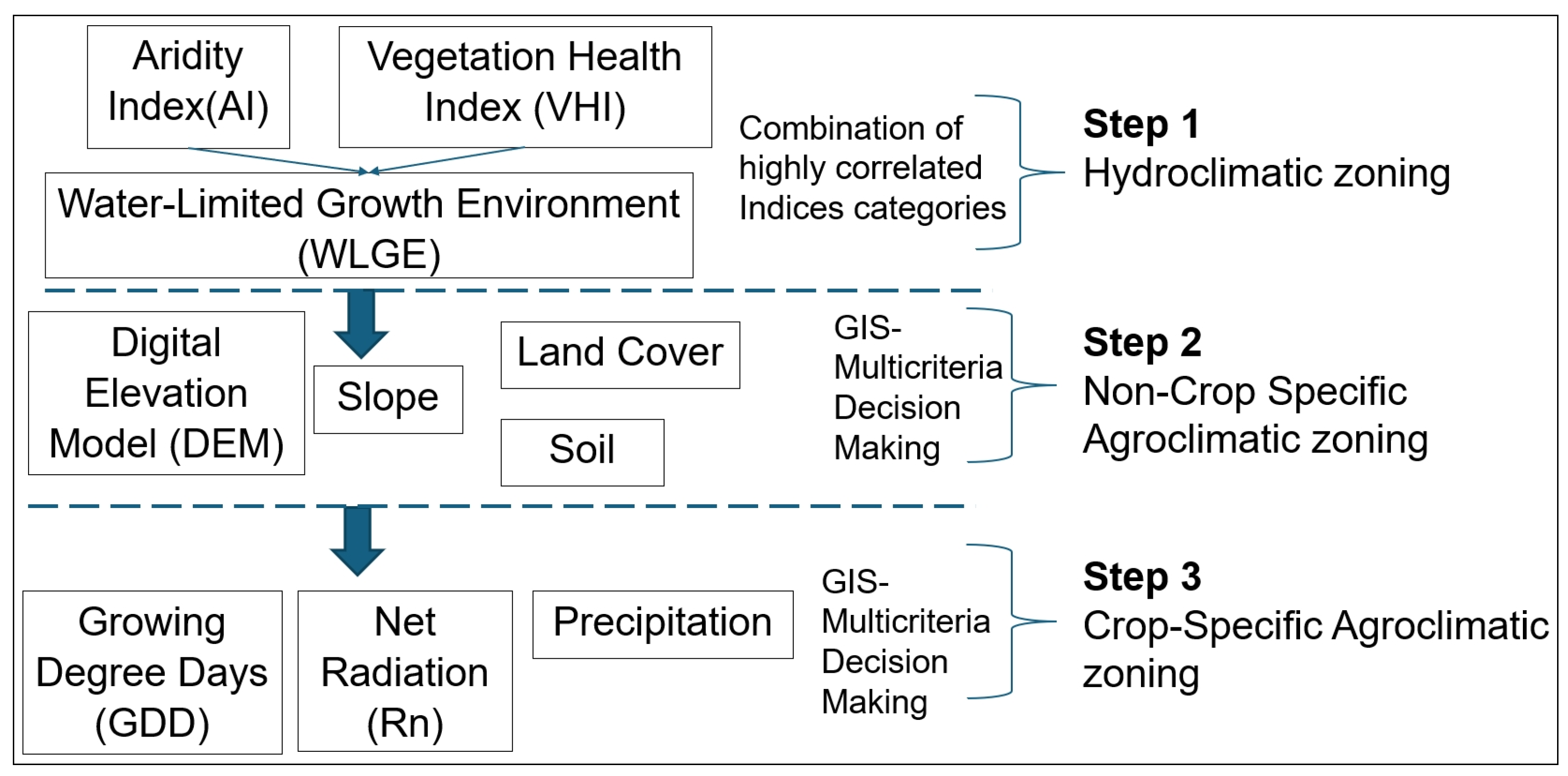
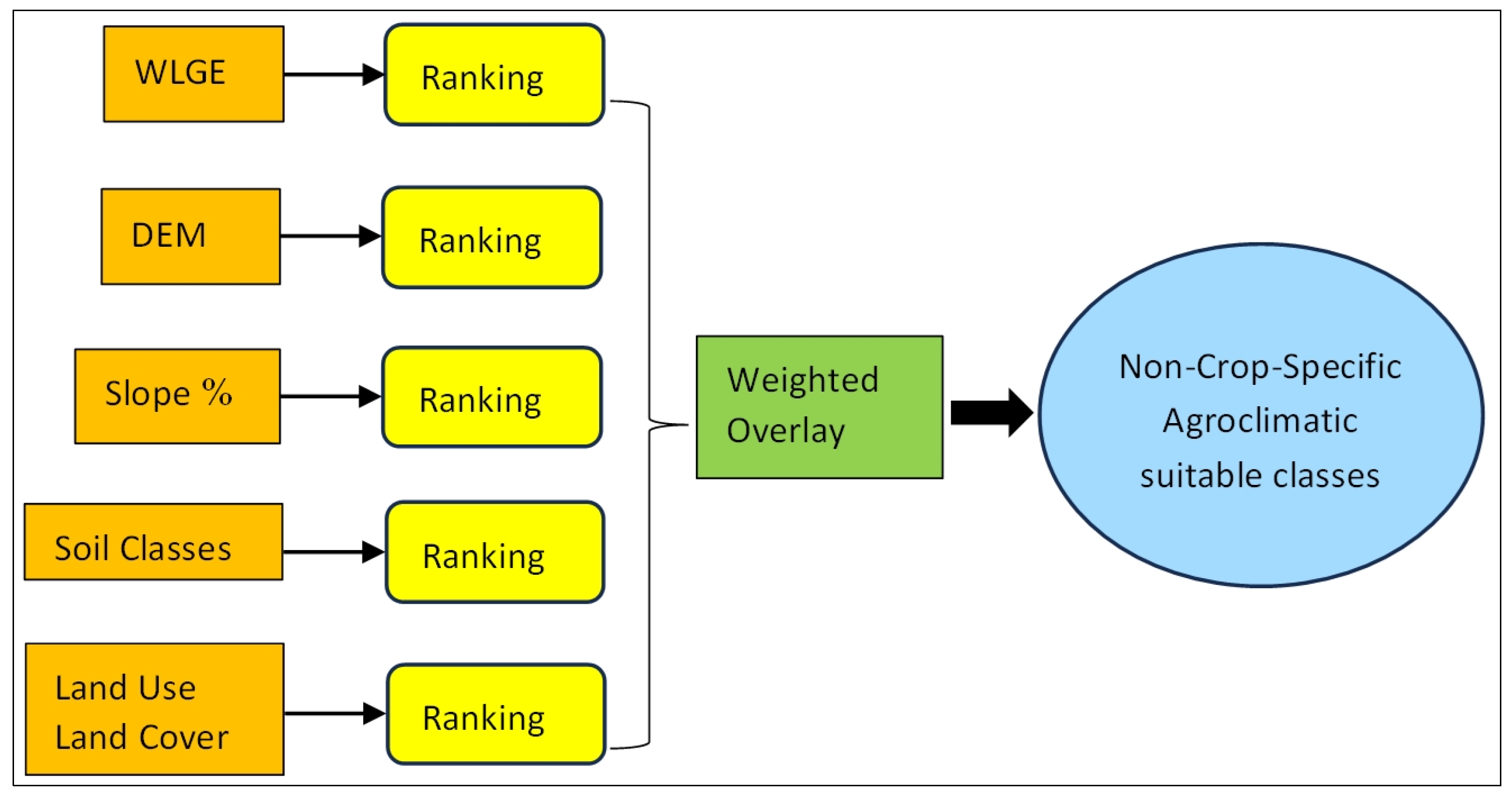

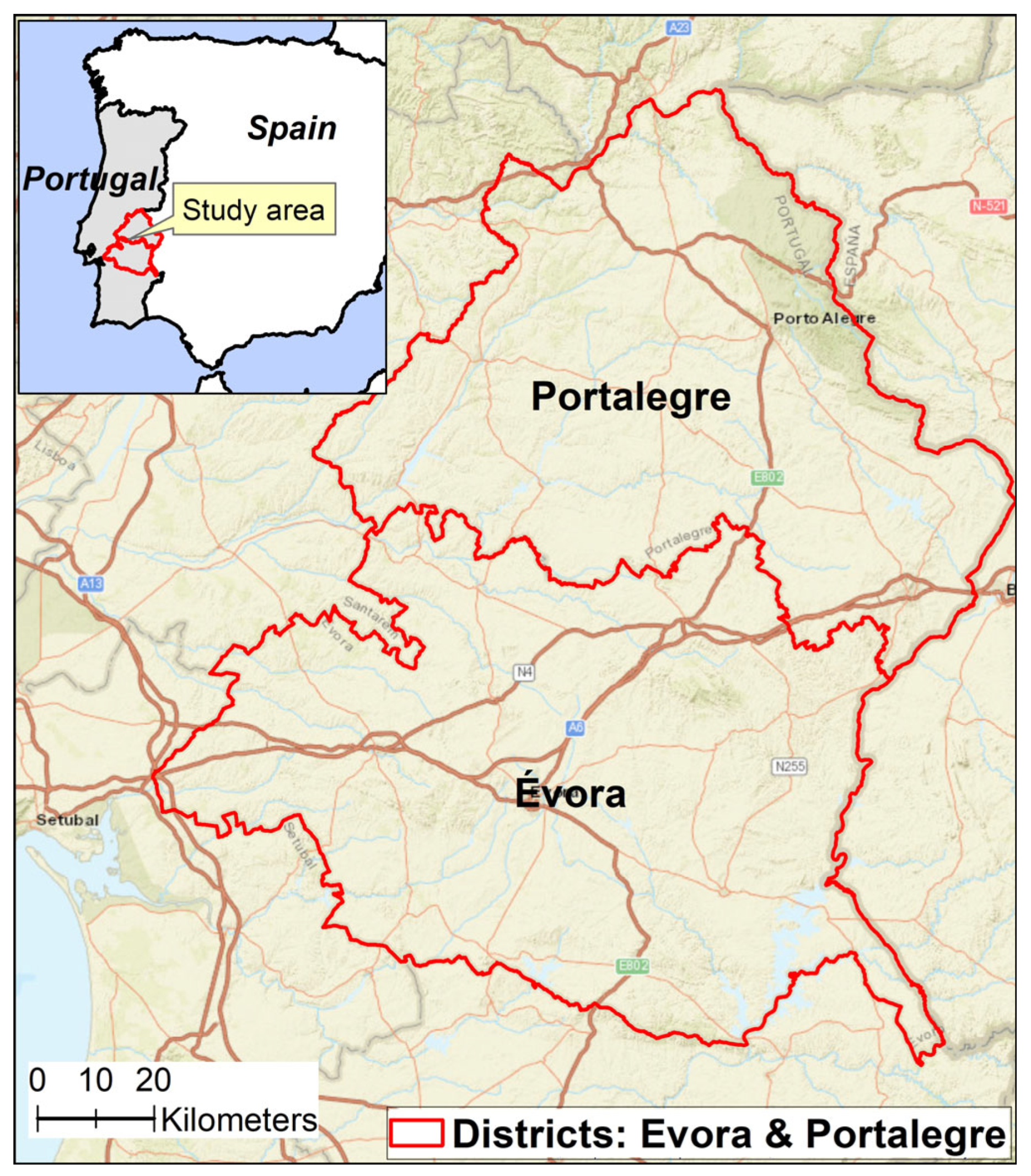
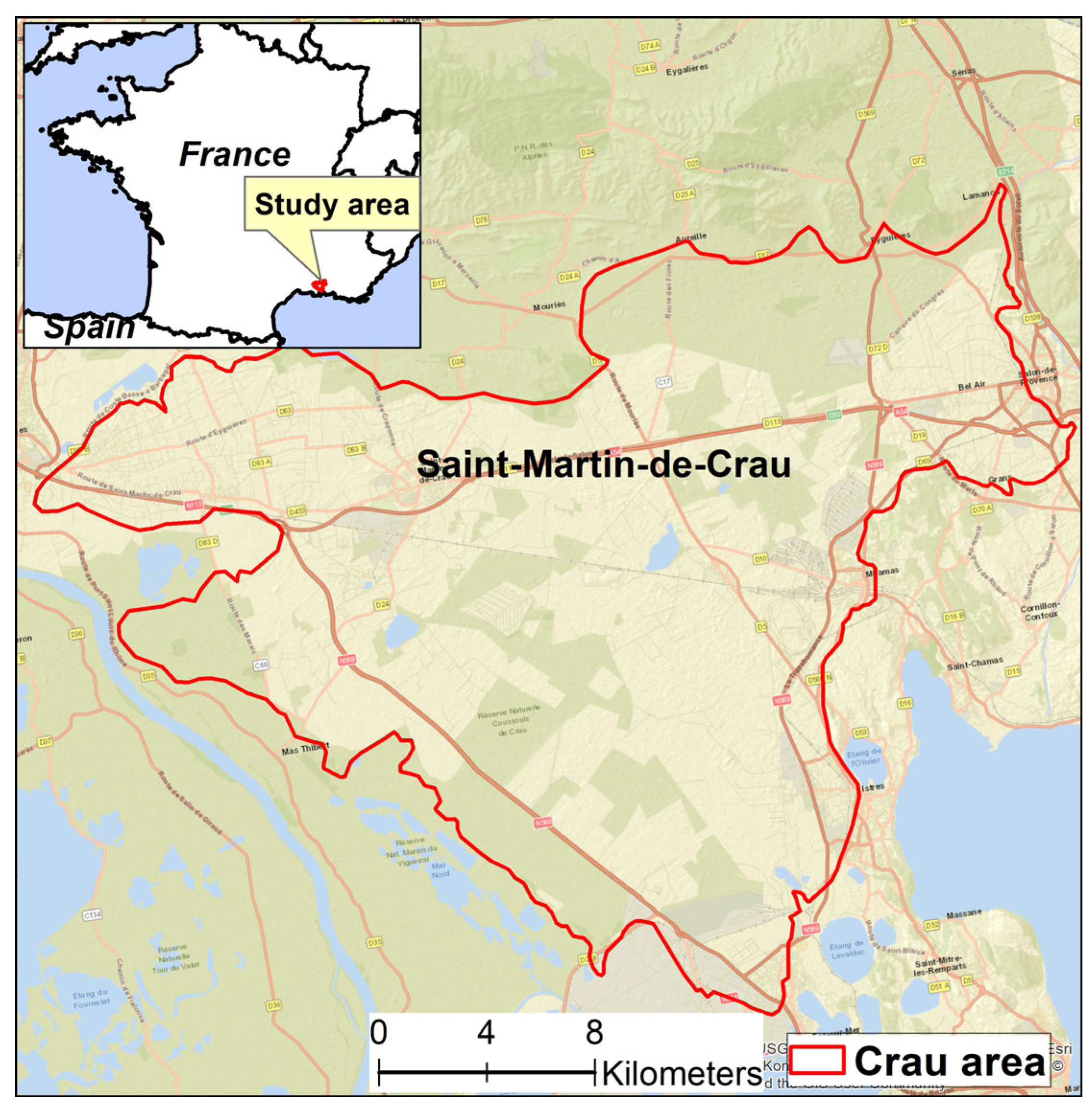
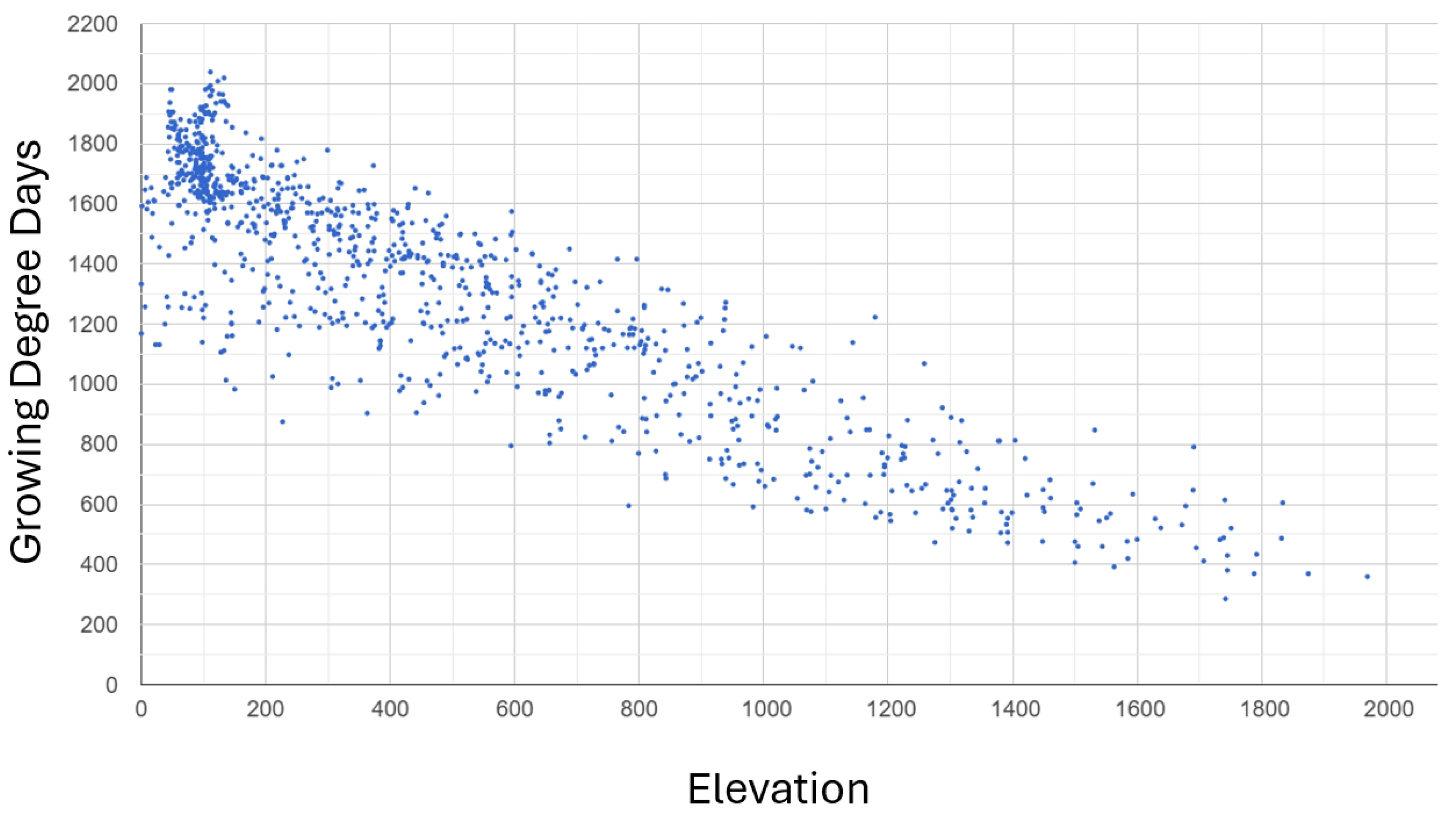

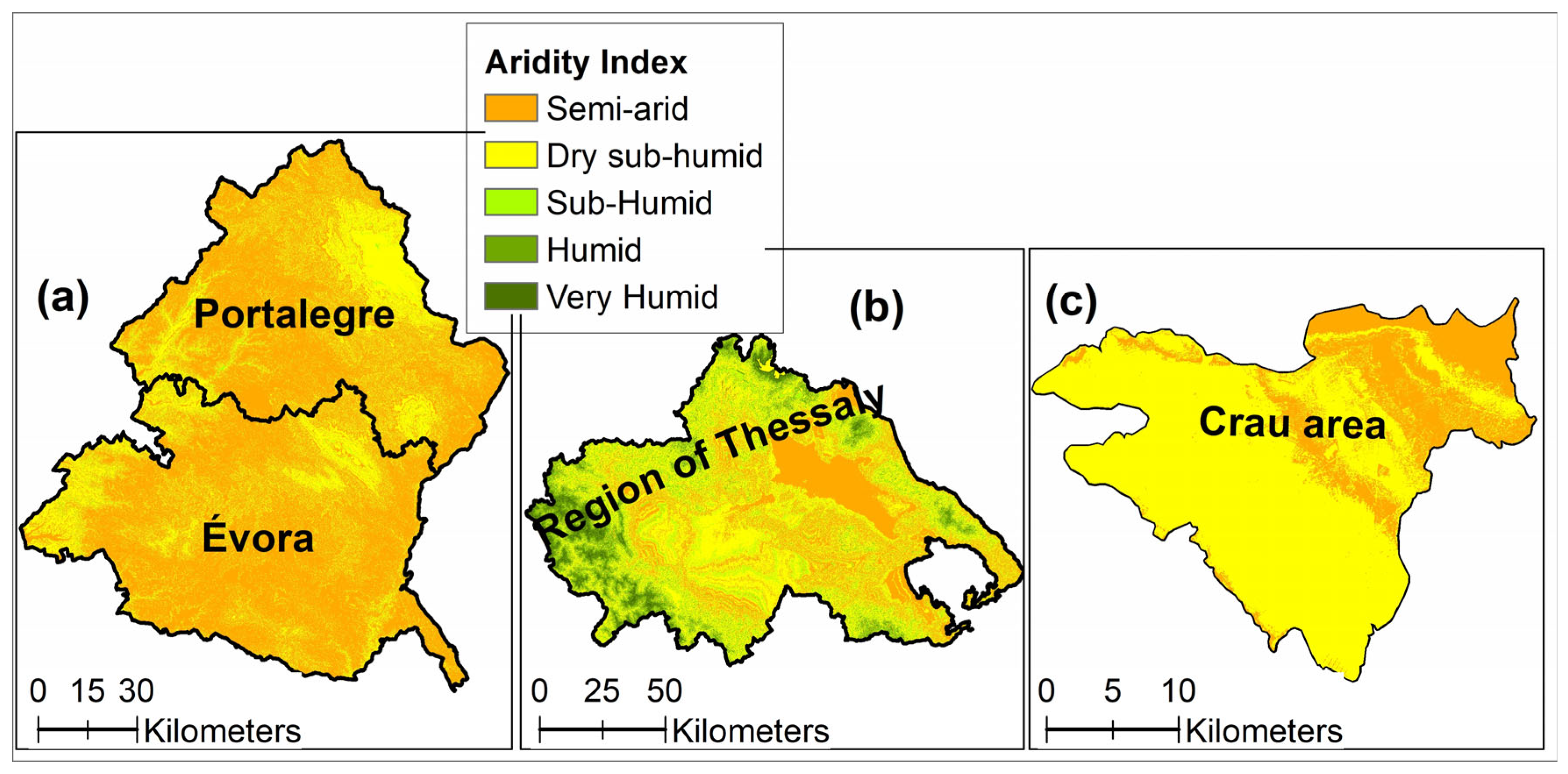
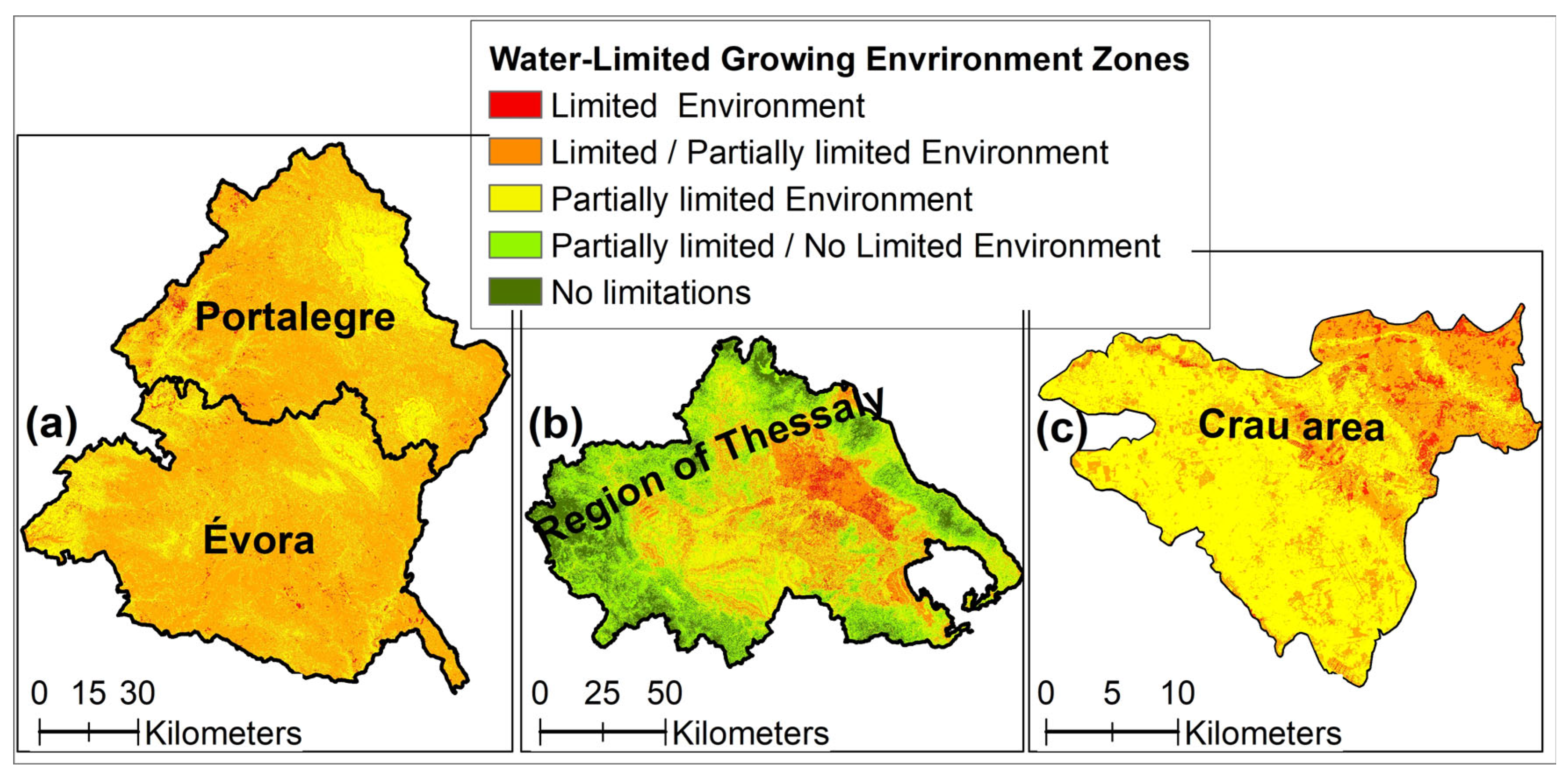
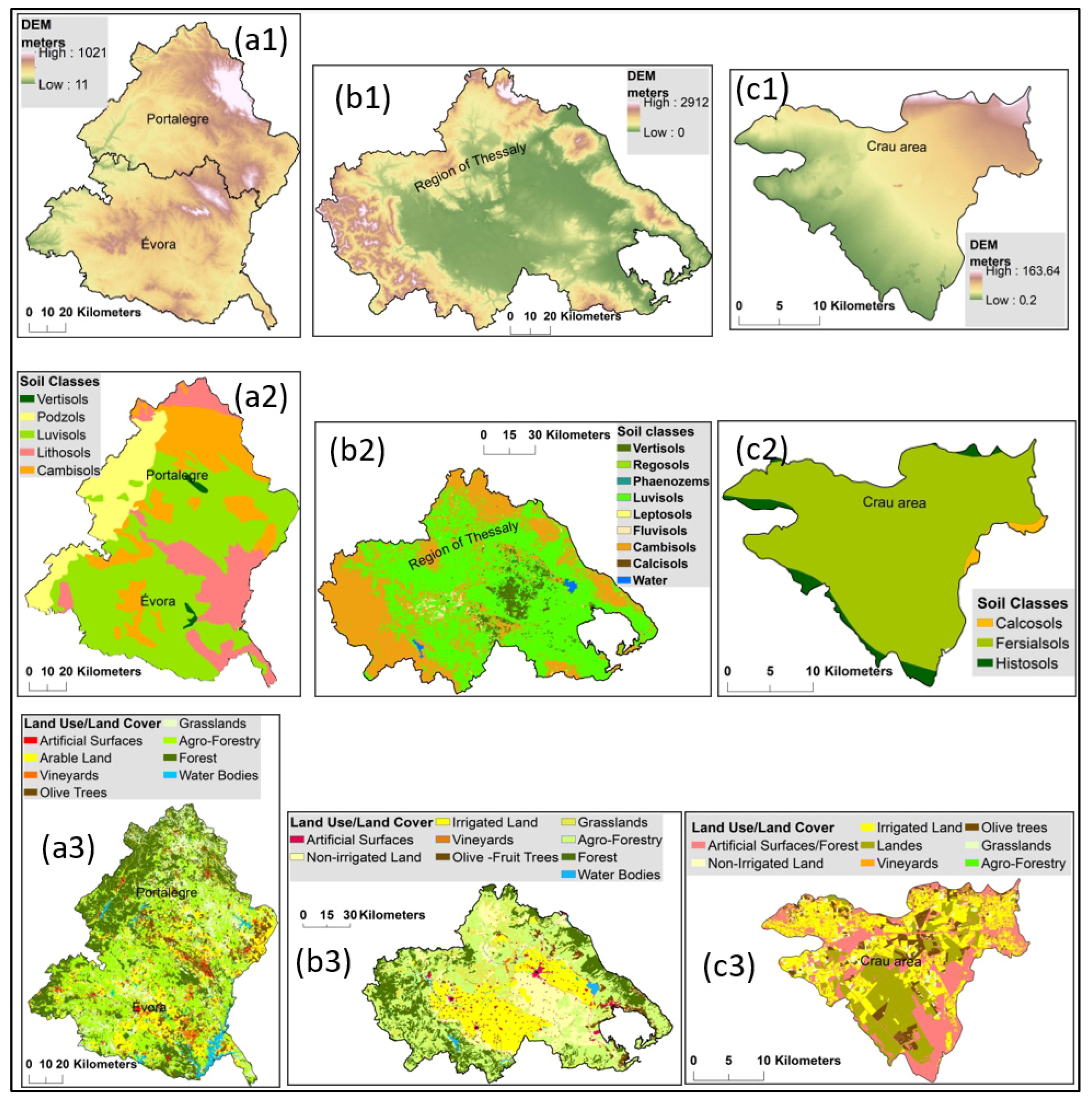

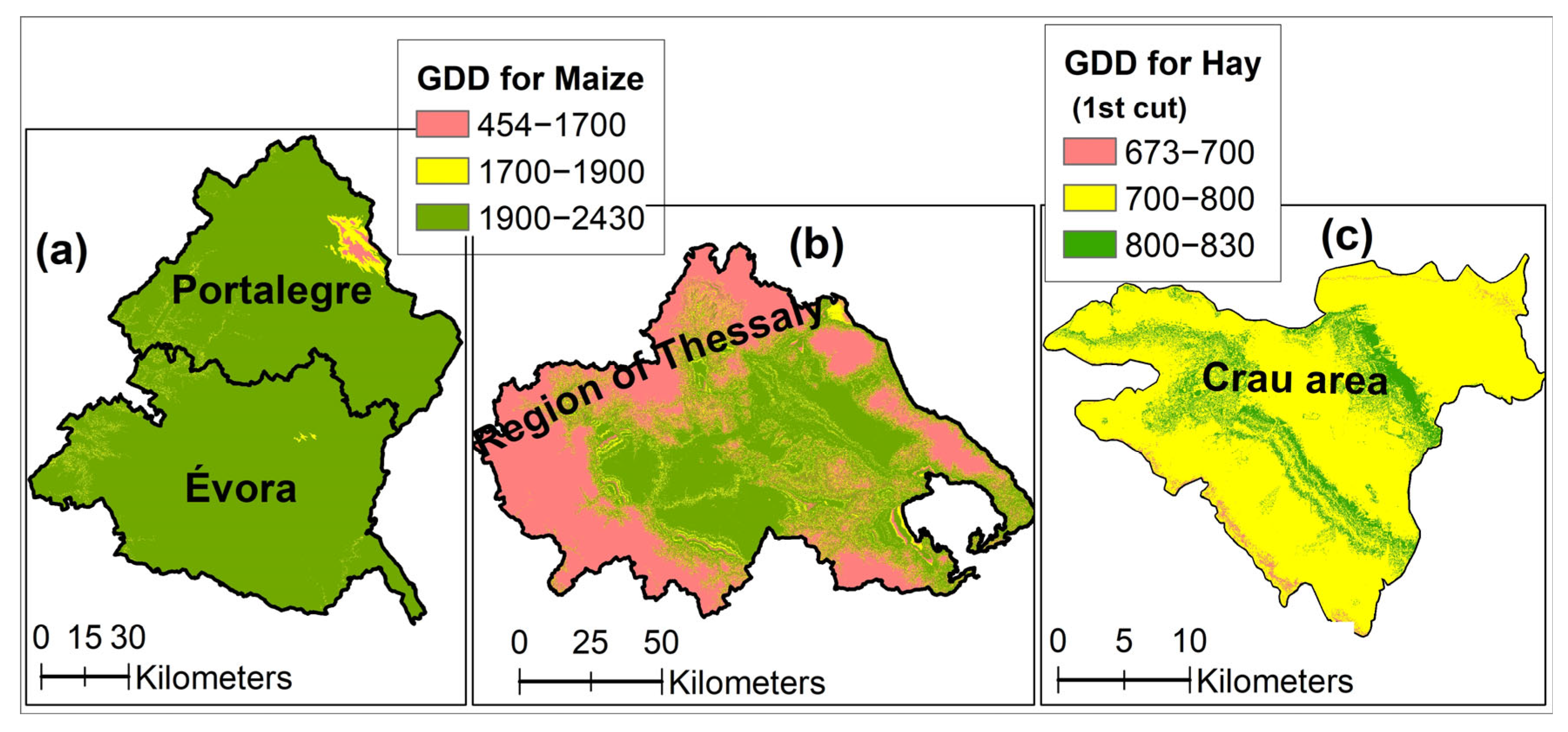

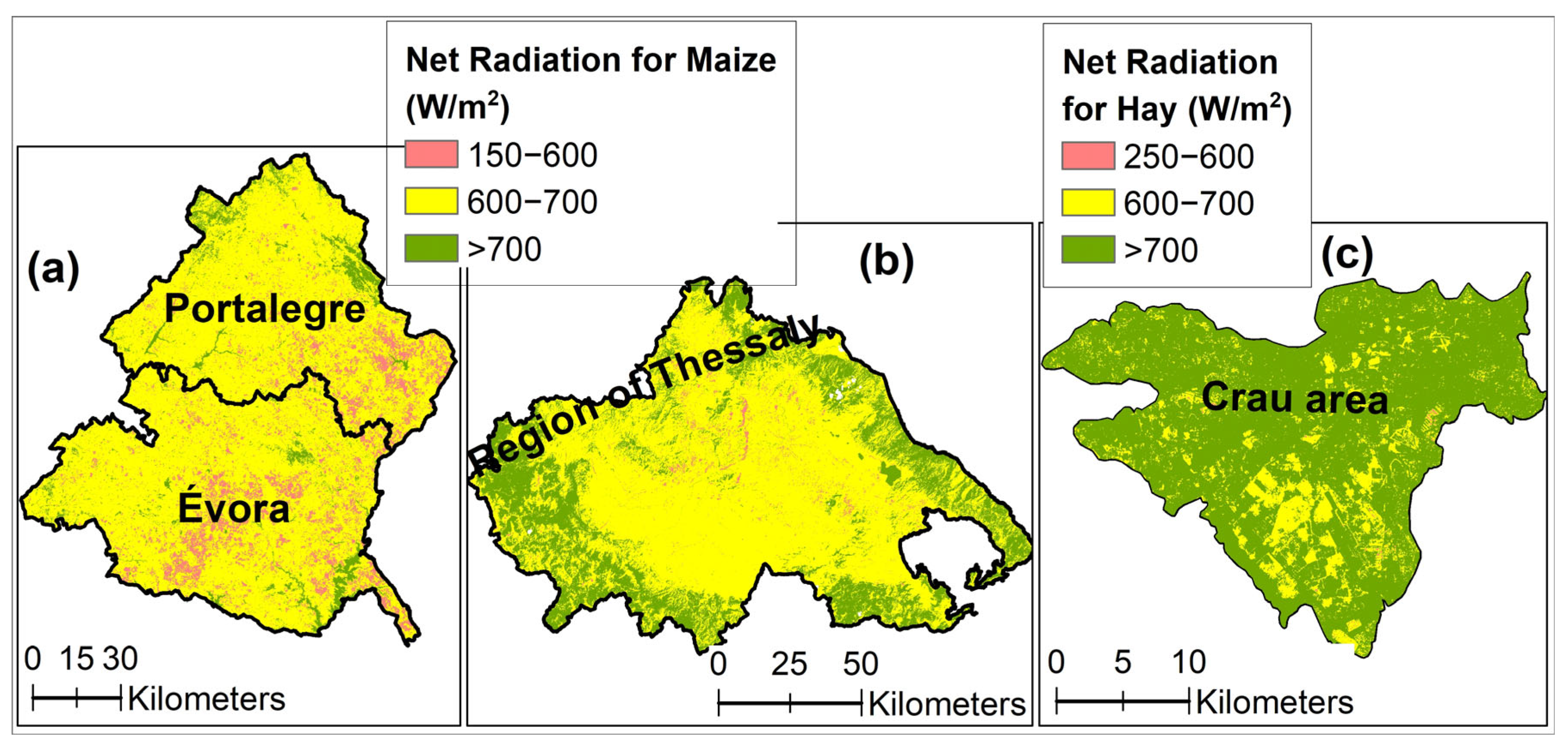

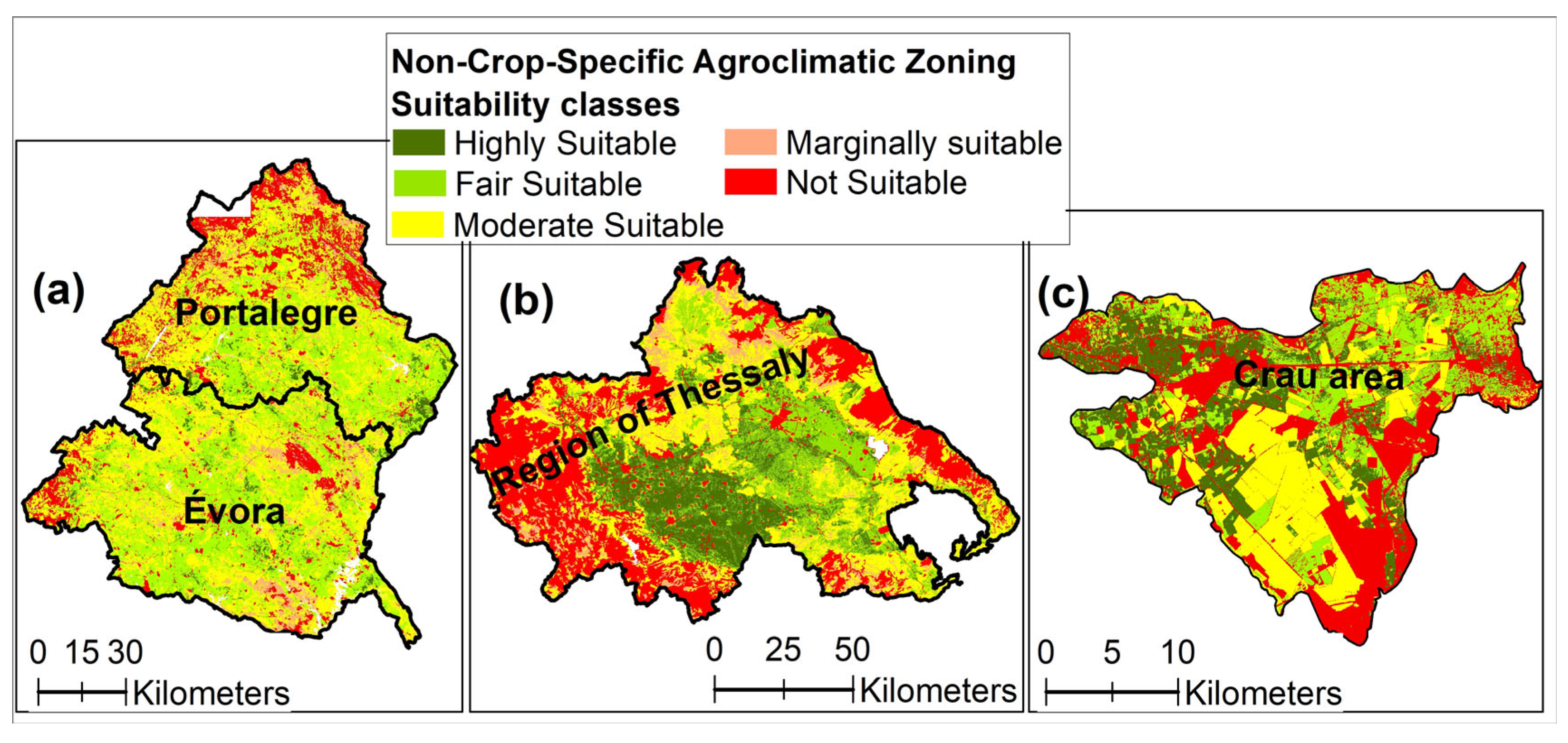


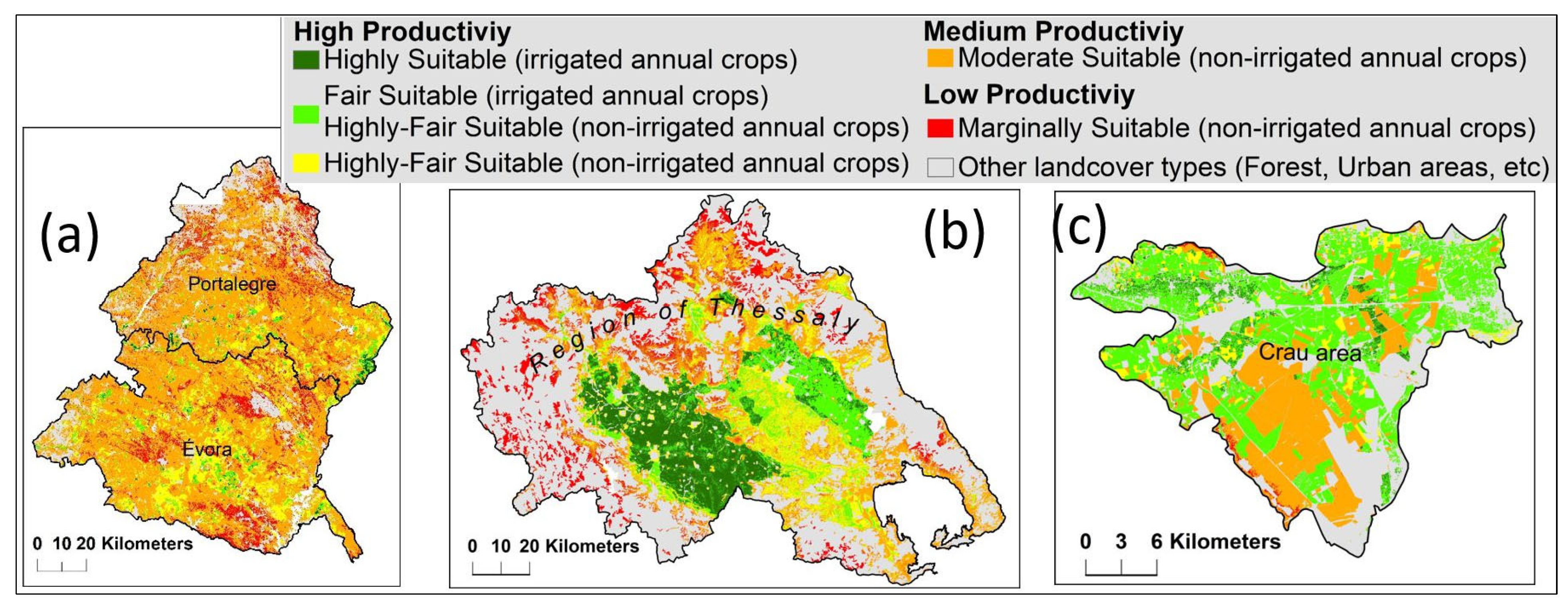
| Severity Classes | Values |
|---|---|
| Extreme | 0–10 |
| Severe | 10–20 |
| Moderate | 20–30 |
| Mild | 30–40 |
| No drought | >40 |
| Classes | Threshold Values |
|---|---|
| Very Humid | AΙ ≥ 1.5 |
| Humid | 1.0 ≤ AΙ < 1.5 |
| Sub-Humid | 0.65 ≤ AI < 1.0 |
| Dry Sub-Humid | 0.5 ≤ AI < 0.65 |
| Semi-Arid | 0.2 ≤ AI < 0.5 |
| Arid | 0.05 ≤ AI < 0.2 |
| Hyper-Arid | AI < 0.05 |
| Vegetation Health Index | Aridity Index | WLGE Classes |
|---|---|---|
| Extreme drought | Hyper-Arid | Limited environment |
| Severe drought | Arid | Limited/Partially limited environment |
| Moderate drought | Semi-Arid/Dry Sub-Humid | Partially limited environment |
| Mild drought | Sub-Humid | Partially limited/No limitations environment |
| No drought | Humid/Very Humid | No limitations |
| Suitability Classes | Suitability Classes (FAO) | Code (FAO) | Description of FAO Agricultural Suitability Classes |
|---|---|---|---|
| Highly Suitable | Highly Suitable | S1 | no or non-significant limitations |
| Fair Suitable | Moderately Suitable | S2m | moderate limitations, due to water deficiency, which reduce productivity |
| Moderate Suitable | Moderately Suitable | S2 | moderately severe constraints that diminish productivity or benefits or that necessitate increased input requirements |
| Marginally suitable | Marginal | N1 | significant limitations exist overall, rendering the current land use only marginally justifiable |
| Not suitable | Permanently not suitable | N2 | limitations of such magnitude that they entirely preclude any possibility of the intended use |
| Criteria | Classes | Ratings | Agricultural Land Suitability |
|---|---|---|---|
| Digital elevation model (DEM) in meters | 0–200 | 10 | Highly Suitable |
| 200–300 | 9 | Fair Suitable | |
| 300–400 | 7 | Moderate Suitable | |
| 400–600 | 5 | ||
| 600–800 | 3 | Marginally Suitable | |
| >800 | 0 | Not Suitable | |
| Slope % | 0–2 (Nearly level) | 10 | Highly |
| 2–8 (Gently sloping) | 9 | Fair Suitable | |
| 8–16 (Moderately sloping) | 7 | Moderate Suitable | |
| 16–30 (Strongly sloping) | 5 | ||
| 30–45 (Steep) | 3 | Marginally Suitable | |
| >45 (Very steep) | 0 | Not Suitable | |
| Soil map | Fluvisols | 10 | Highly Suitable |
| Cambisols | 9 | Fair Suitable | |
| Luvisols | 9 | ||
| Calcisols | 5 | Moderate Suitable | |
| Regosols | 5 | ||
| Kastanozems | 3 | Marginally suitable | |
| Leptosols | 0 | Not suitable | |
| Land use/ Land cover | Annual crops | 10 | Highly Suitable |
| Arboriculture | 9 | Fair Suitable | |
| Grasslands | 3 | Marginally Suitable | |
| Human-made areas/Forests/Water bodies, etc. | 0 | Not Suitable | |
| WLGE zoning | No limitations | 10 | Highly Suitable |
| Partially limited/No limitations | 9 | Fair Suitable | |
| Partially limited | 7 | Moderate Suitable | |
| Limited/Partially limited | 5 | ||
| Limited environment | 3 | Marginally Suitable |
| Variables | Weight % | ||
|---|---|---|---|
| Greece | Portugal | France | |
| WLGE | 30 | 30 | 40 |
| Land Use/Land Cover | 20 | 20 | 20 |
| Soil Types | 20 | 20 | 20 |
| DEM | 15 | 10 | 10 |
| Slope | 15 | 20 | 10 |
| Study Areas | Crop Type |
|---|---|
| Portugal (Évora and Portalegre) | Winter wheat—Maize |
| Greece (Thessaly) | Winter wheat—Maize |
| France (Crau) | Winter wheat—Hay |
| Study Area | Crop Type | Tbase (°C) | Tsum °C-d | Growing Season |
|---|---|---|---|---|
| Portugal | Winter wheat | 0 | 2105 | January–15 June |
| Maize | 10 | 1800 | April–September | |
| Greece | Winter wheat | 4 | 2105 | January–15 June |
| Maize | 10 | 1800 | April–September | |
| France | Winter wheat | 0 | 2105 | January–15 June |
| Hay | 5.6 | 700 | March–May |
| Non-Crop-Specific Agroclimatic Zones | Évora-Portalegre in Portugal | Thessaly Region in Greece | Crau Area in France | |||
|---|---|---|---|---|---|---|
| Acreage (Ha) | % | Acreage (Ha) | % | Acreage (Ha) | % | |
| Highly Suitable | 35,700 | 2.7 | 205,625 | 15.0 | 15,146 | 27.9 |
| Fair Suitable | 486,308 | 36.1 | 250,572 | 18.3 | 13,184 | 24.3 |
| Moderate Suitable | 514,204 | 38.2 | 405,950 | 29.6 | 12,820 | 23.6 |
| Marginally Suitable | 76,280 | 5.7 | 88,648 | 6.5 | 21 | 0.0 |
| Not Suitable | 233,308 | 17.3 | 419,205 | 30.6 | 13,129 | 24.2 |
| Total | 1,345,800 | 100 | 1,370,000 | 100 | 54,300 | 100 |
| Wheat Crop-Specific Agroclimatic Zones | Évora-Portalegre in Portugal | Thessaly Region in Greece | Crau Area in France | |||
|---|---|---|---|---|---|---|
| Acreage (Ha) | % | Acreage (Ha) | % | Acreage (Ha) | % | |
| Highly Suitable | 44,102 | 3.28 | 126,980 | 9.27 | 10,337 | 19.04 |
| Fair Suitable | 175,896 | 13.07 | 274,120 | 20.01 | 13,303 | 24.5 |
| Moderate Suitable | 756,184 | 56.19 | 210,629 | 15.37 | 12,652 | 23.30 |
| Marginally Suitable | 136,310 | 10.13 | 105,426 | 7.7 | 269 | 0.50 |
| Not Suitable | 233,308 | 17.33 | 652,845 | 47.65 | 17,739 | 32.66 |
| Total | 1,345,800 | 100 | 1,370,000 | 100 | 54,300 | 100 |
| Crop-Specific Agroclimatic Zones | Évora-Portalegre in Portugal | Thessaly Region in Greece | Crau Area in France | |||
|---|---|---|---|---|---|---|
| Acreage (Ha) Maize | % | Acreage (Ha) Maize | % | Acreage (Ha) Hay (1st Cut) | % | |
| Highly Suitable | 8396 | 0.62 | 144,148 | 10.52 | 1580 | 2.91 |
| Fair Suitable | 41,633 | 3.09 | 78,204 | 5.71 | 19,718 | 36.31 |
| Moderate Suitable | 243,540 | 18.10 | 3714 | 0.27 | 1483 | 2.73 |
| Marginally Suitable | 47,163 | 3.50 | 1388 | 0.10 | 12,779 | 23.53 |
| Not Suitable | 1,005,068 | 74.69 | 1,142,546 | 83.40 | 18,740 | 34.52 |
| Total | 1,345,800 | 100 | 1,370,000 | 100 | 54,300 | 100 |
| Productivity Agroclimatic Zones | Évora-Portalegre in Portugal | Thessaly Region in Greece | Crau Area in France | |||
|---|---|---|---|---|---|---|
| Acreage (Ha) | % | Acreage (Ha) | % | Acreage (Ha) | % | |
| High Productivity | ||||||
| Highly Suitable (irrigated annual crops) | 8394 | 0.6 | 144,148 | 10.5 | 1580 | 2.9 |
| Fair Suitable (irrigated annual crops) Highly–Fair suitable (non-irrigated annual crops) | 41,621 | 3.1 | 78,204 | 5.7 | 19,718 | 36.3 |
| Highly–Fair suitable (non-irrigated annual crops) | 174,537 | 13.0 | 178,831 | 13.0 | 2341 | 4.3 |
| Medium Productivity | ||||||
| Moderate Suitable (non-irrigated annual crops) | 748,726 | 55.6 | 210,545 | 15.4 | 12,652 | 23.3 |
| Low Productivity | ||||||
| Marginally Suitable non-irrigated annual crops) | 134,861 | 10.0 | 105,427 | 7.7 | 269 | 0.5 |
| Not Suitable | 237,661 | 17.7 | 652,845 | 47.7 | 17,740 | 32.7 |
| Total | 1,345,800 | 100 | 1,370,000 | 100 | 54,300 | 100 |
Disclaimer/Publisher’s Note: The statements, opinions and data contained in all publications are solely those of the individual author(s) and contributor(s) and not of MDPI and/or the editor(s). MDPI and/or the editor(s) disclaim responsibility for any injury to people or property resulting from any ideas, methods, instructions or products referred to in the content. |
© 2025 by the authors. Licensee MDPI, Basel, Switzerland. This article is an open access article distributed under the terms and conditions of the Creative Commons Attribution (CC BY) license (https://creativecommons.org/licenses/by/4.0/).
Share and Cite
Faraslis, I.; Dalezios, N.R.; Spiliotopoulos, M.; Tziatzios, G.A.; Sakellariou, S.; Dercas, N.; Giannousa, K.; Belaud, G.; Daudin, K.; Cameira, M.d.R.; et al. Satellite-Based Innovative Agroclimatic Classification Under Reduced Water Availability: Identification of Optimal Productivity Zones. Land 2025, 14, 2147. https://doi.org/10.3390/land14112147
Faraslis I, Dalezios NR, Spiliotopoulos M, Tziatzios GA, Sakellariou S, Dercas N, Giannousa K, Belaud G, Daudin K, Cameira MdR, et al. Satellite-Based Innovative Agroclimatic Classification Under Reduced Water Availability: Identification of Optimal Productivity Zones. Land. 2025; 14(11):2147. https://doi.org/10.3390/land14112147
Chicago/Turabian StyleFaraslis, Ioannis, Nicolas R. Dalezios, Marios Spiliotopoulos, Georgios A. Tziatzios, Stavros Sakellariou, Nicholas Dercas, Konstantina Giannousa, Gilles Belaud, Kevin Daudin, Maria do Rosário Cameira, and et al. 2025. "Satellite-Based Innovative Agroclimatic Classification Under Reduced Water Availability: Identification of Optimal Productivity Zones" Land 14, no. 11: 2147. https://doi.org/10.3390/land14112147
APA StyleFaraslis, I., Dalezios, N. R., Spiliotopoulos, M., Tziatzios, G. A., Sakellariou, S., Dercas, N., Giannousa, K., Belaud, G., Daudin, K., Cameira, M. d. R., Paredes, P., & Rolim, J. (2025). Satellite-Based Innovative Agroclimatic Classification Under Reduced Water Availability: Identification of Optimal Productivity Zones. Land, 14(11), 2147. https://doi.org/10.3390/land14112147














